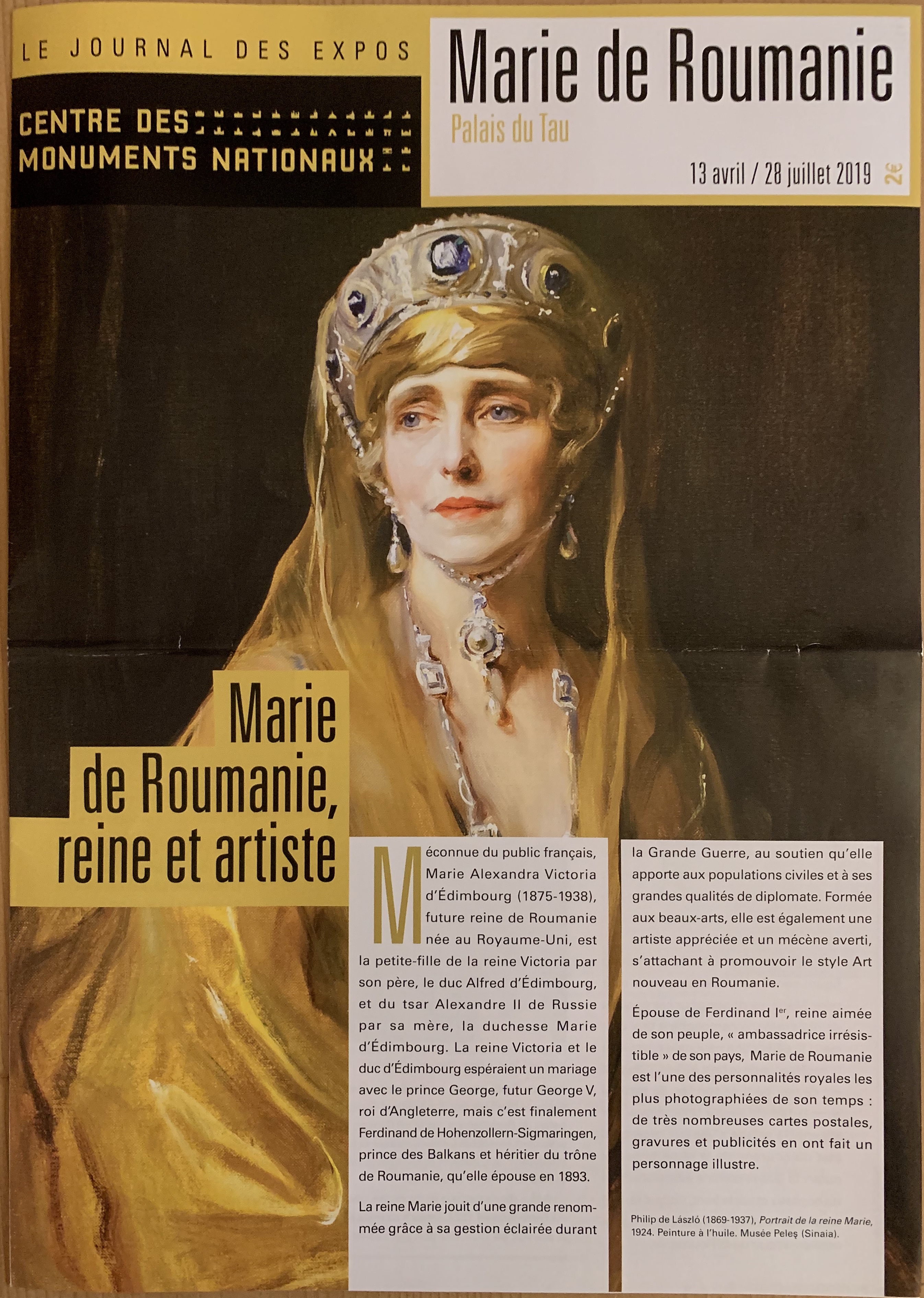
New Book: Exile and Rivalry. Prince Nicholas (of Romania), April 2024
28 Thursday Mar 2024

28 Thursday Mar 2024

02 Thursday May 2019
Tags
Exhibition in Reims Palais du Tau, exposition Marie de Roumanie reine et artiste, Marie de Roumanie, Marie de Roumanie reine et artiste, Palais du Tau exposition Reine Marie, Queen Marie of Romania, Queen Marie of Romania in Reims
The exhibition “Marie de Roumanie, reine & artiste” (13 April – 28 July 2019, Palais du Tau, Reims) presents symbol laden objects, survivors of dramatic political changes in her country and the continent, which once belonged to the Queen’s collection, all being marked by her creed “Per Amore ad Lucem”, leading us into a world of symbols of Queen Marie. The historical record of Queen Marie’s patrimony has been one highly conditioned by the shifting grounds of the intervening political regimes and legislations. Many of the objects were thus lost, scattered in many places, confiscated by the communists in 1948, or destroyed in the upheavals of the 20th century, but their memory and beauty can still be glimpsed in old photographs, documents, or as museum exhibits.










Photos by DM, MB, MA/ MNIR

22 Monday Apr 2019
Tags
Diana Mandache curator, Exhibition dedicated to Queen Marie of Romania, Exhibition in Reims Palais du Tau, Exposition, France, Marie de Roumanie reine et artiste, Palais du Tau, Queen Marie of Romania in Reims, Reims, Reine Marie de Roumanie
” Marie de Roumanie, reine & artiste” – exhibition opened at Palais du Tau in Reims, France: 13 April-28 July 2019. Queen Marie’s regalia is displayed for the first time in an international exhibition.

Queen Marie by Philip de Laszlo, oil painting, 1924 – exhibited at Palais du Tau. Once the painting adorned the reception room from the Cotroceni Royal Palace in Bucharest, today belongs to Peles Museum in Sinaia.
Queen Marie is one of the important personalities of modern Romania, a flamboyant and charismatic royalty. She continued to fascinate even after her death due to her character and education achieved at the Victorian court and circles. Marie’s nature and imperial ascendency imprinted her actions with courage, spontaneity, sometimes vanity, artistic sensibility and originality. She had been a talented painter, photographer, a royal diplomat, writer, and also a curious traveller who explored North America and the Middle East, including Egypt, where she went to see and get informed about the famous discoveries of the British archeologist Howard Carter.
100 years ago, in the aftermath of the Great War, the Romanian government entrusted Queen Marie with an informal mission to Paris, where she met the leaders of the Peace Conference, among them Georges Clemenceau, Woodrow Wilson, David Lloyd George. As she later wrote, “So many diplomats and politicians were having their say that it was difficult to get a hearing. It needed an exceptional ambassador to plead for a country which did not enjoy special popularity”. At the same time, she gave interviews, also holding press conferences, a novelty for a royalty. “I’m glad the Press is nice about me, it’s something gained for Romania! All honour shown to me is shown to my country – so if Paris goes off its head, a bit about me, all the better; it opens the way for the work I have to do”. The Queen thus has been lobbying for Romania, and her image was associated with her country.
Queen Marie did not wear a tiara or other important jewels at any of the meetings or dinners at which she was invited, as the royal protocol would have required. She lost most of those adornments in Bolshevik Russia, where they were sent during the war by the Romanian government for safekeeping, within the first such transport, in December 1916, which also included the state treasury. The jewel maker, Cartier, offered to lend her a tiara, but she respectfully declined it, perhaps wanting to draw attention to the precarious situation of the Romanian state treasury, now lost in Russia under the Bolsheviks, a problem that was also raised at the conference by the representative of the National Bank of Romania, G. Danielopolu, in April 1919, within the Reparations Commission.
The historical record of Queen Marie’s patrimony has been one highly conditioned by the shifting grounds of the intervening political regimes and legislations. Many of the objects were thus lost, scattered in many places, confiscated by the communists in 1948, or destroyed in the upheavals of the 20th century, but their memory and beauty can still be glimpsed in old photographs or documents, her correspondence, bills and her will. The old photographs, paintings, regalia, jewellery, personal objects, exude the spirit of a princess, who later became a queen, and was a keen collector of jewels and art of a multitude of styles and fashions, from the Byzantine designs to the Victorian ones, from flamboyant Art Nouveau to the reduced to essence Art Deco.
The exhibition “Marie de Roumanie, reine & artiste” presents symbol laden objects, survivors of dramatic political changes in her country and the continent, which once belonged to the Queen’s collection, all being marked by her creed “Per Amore ad Lucem”, leading us into a world of symbols of Queen Marie.
This exhibition is a tribute to a great personality of Romania, whose fate and actions were so much intertwined with many European countries, including France, making from her a sort of avant-la-lettre European.
This cultural event would not have been possible without the concourse of our partners from France, especially the colleagues at Centre des Monuments Nationaux and the illustrious host Palais du Tau, to all of whom I would like to address my thanks on behalf of my colleagues from the National History Museum of Romania, also from Peles Museum and the Romanian partner institutions, for their collective effort and cooperation in making possible this interesting and timely project.
Curator: Dr Diana Mandache, Historian

You must be logged in to post a comment.